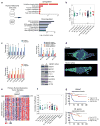FBXW7 regulates a mitochondrial transcription program by modulating MITF
- PMID: 29665239
- PMCID: PMC6192859
- DOI: 10.1111/pcmr.12704
FBXW7 regulates a mitochondrial transcription program by modulating MITF
Abstract
FBXW7 is well characterized as a tumor suppressor in many human cancers including melanoma; however, the mechanisms of tumor-suppressive function have not been fully elucidated. We leveraged two distinct RNA sequencing datasets: human melanoma cell lines (n = 10) with control versus silenced FBXW7 and a cohort of human melanoma tumor samples (n = 51) to define the transcriptomic fingerprint regulated by FBXW7. Here, we report that loss of FBXW7 enhances a mitochondrial gene transcriptional program that is dependent on MITF in human melanoma and confers poor patient outcomes. MITF is a lineage-specific master regulator of melanocytes and together with PGC-1alpha is a marker for melanoma subtypes with dependence for mitochondrial oxidative metabolism. We found that inactivation of FBXW7 elevates MITF protein levels in melanoma cells. In vitro studies examining loss of FBXW7 and MITF alone or in combination showed that FBXW7 is an upstream regulator for the MITF/PGC-1 signaling.
Keywords: FBXW7; MITF; PGC-1alpha; melanoma; metabolism; mitochondria.
© 2018 John Wiley & Sons A/S. Published by John Wiley & Sons Ltd.
Conflict of interest statement
The authors declare no conflict of interest.
Figures


Similar articles
-
PGC-1 coactivators regulate MITF and the tanning response.Mol Cell. 2013 Jan 10;49(1):145-57. doi: 10.1016/j.molcel.2012.10.027. Epub 2012 Nov 29. Mol Cell. 2013. PMID: 23201126 Free PMC article.
-
ATP-Citrate Lyase Epigenetically Potentiates Oxidative Phosphorylation to Promote Melanoma Growth and Adaptive Resistance to MAPK Inhibition.Clin Cancer Res. 2020 Jun 1;26(11):2725-2739. doi: 10.1158/1078-0432.CCR-19-1359. Epub 2020 Feb 7. Clin Cancer Res. 2020. PMID: 32034077
-
Oncogenic BRAF regulates oxidative metabolism via PGC1α and MITF.Cancer Cell. 2013 Mar 18;23(3):302-15. doi: 10.1016/j.ccr.2013.02.003. Epub 2013 Mar 7. Cancer Cell. 2013. PMID: 23477830 Free PMC article.
-
[The Importance of MITF Signaling Pathway in the Regulation of Proliferation and Invasiveness of Malignant Melanoma].Klin Onkol. 2016 Fall;29(5):347-350. doi: 10.14735/amko2016347. Klin Onkol. 2016. PMID: 27739313 Review. Czech.
-
MITF in melanoma: mechanisms behind its expression and activity.Cell Mol Life Sci. 2015 Apr;72(7):1249-60. doi: 10.1007/s00018-014-1791-0. Epub 2014 Nov 30. Cell Mol Life Sci. 2015. PMID: 25433395 Free PMC article. Review.
Cited by
-
Adaptive Responses as Mechanisms of Resistance to BRAF Inhibitors in Melanoma.Cancers (Basel). 2019 Aug 14;11(8):1176. doi: 10.3390/cancers11081176. Cancers (Basel). 2019. PMID: 31416288 Free PMC article. Review.
-
FBXW7 in Cancer: What Has Been Unraveled Thus Far?Cancers (Basel). 2019 Feb 19;11(2):246. doi: 10.3390/cancers11020246. Cancers (Basel). 2019. PMID: 30791487 Free PMC article. Review.
-
FBXW7 alleviates hyperglycemia-induced endothelial oxidative stress injury via ROS and PARP inhibition.Redox Biol. 2022 Dec;58:102530. doi: 10.1016/j.redox.2022.102530. Epub 2022 Nov 15. Redox Biol. 2022. PMID: 36427396 Free PMC article.
-
Neddylation regulation of mitochondrial structure and functions.Cell Biosci. 2021 Mar 17;11(1):55. doi: 10.1186/s13578-021-00569-6. Cell Biosci. 2021. PMID: 33731189 Free PMC article. Review.
-
Identifying novel circadian rhythm biomarkers for diagnosis and prognosis of melanoma by an integrated bioinformatics and machine learning approach.Aging (Albany NY). 2024 Jun 20;16(16):11824-11842. doi: 10.18632/aging.205961. Epub 2024 Jun 20. Aging (Albany NY). 2024. PMID: 39213172 Free PMC article.
References
Publication types
MeSH terms
Substances
Grants and funding
LinkOut - more resources
Full Text Sources
Other Literature Sources
Medical

